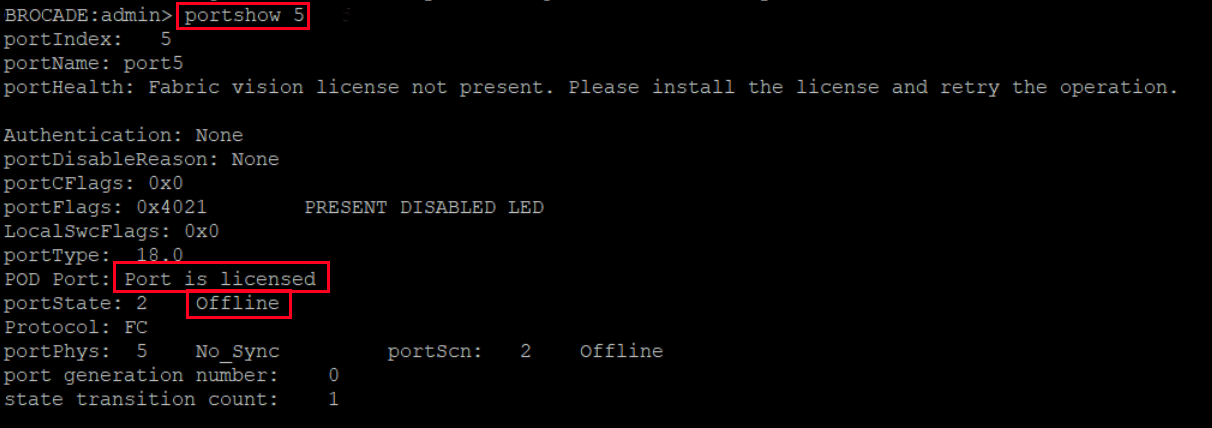

- #Brocade san switch serial connection how to
- #Brocade san switch serial connection license
- #Brocade san switch serial connection Offline
Brocade SW300 connect IBM Flex system FC3171 SAN switch issue Without a connection, the TH port is downed.Ģ.

Any TH (external or internal) port must be mapped to a TF port to activate the connection and allow data to pass through. If a TH port is mapped to a TF port and the TF port is online, the TH port will be listed as online.

#Brocade san switch serial connection Offline
If a TH port is mapped to a TF port but the TF port is offline or non existent, the TH port will be listed as downed. If a TH port is not mapped to a TF port, the TH port will be listed as offline. NOTE: How ports are mapped affects the operational state of TH ports. * TH ports 3 - 14 are mapped to TF port 0 * TH ports 1 and 2 are mapped to TF port 15 * TH ports 12, 13, and 14 are mapped to TF port 19īy default, the backup ports are mapped as follows: * TH ports 10 and 11 are mapped to TF port 18 * TH ports 8 and 9 are mapped to TF port 17 * TH ports 5, 6, and 7 are mapped to TF port 16 * TH ports 3 and 4 are mapped to TF port 15 * TH ports 1 and 2 are mapped to TF port 0 Ports designated as backup ports only become active when all primary ports fail.īy default, the primary ports are mapped as follows: If there are multiple primary ports, the TH ports are distributed (using an algorithm) across the TF ports. A port designated as primary will be the first path chosen. You can map multiple primary and backup ports for any TH port. Leaving a TH port unmapped has the same effect as unplugging a Fibre Channel cable. To open the Map Ports dialog, open the Port menu, and select Map Ports. For redundancy purposes, a backup port mapping can also be specified. Using the Map Ports dialog, you can assign a TH port to multiple TF ports. By default, the 6 uplink (external) ports are TF ports. When an uplink port is connected to a fabric switch, it is called a TF (Transparent Fabric) Port. At least 1 uplink port must connect to a fabric switch that supports NPIV (N-Port ID Virtualization). When an uplink port is used to attach an external server, it must be configured to a TH port. Server bay ports are referred to as TH (Transparent Host) ports. The Map Ports dialog enables you to configure data traffic routes from server bay ports to one or more uplink ports.
#Brocade san switch serial connection license
If available, the license is displayed under Feature Licenses. (It comes with the blade enclosure in this case.) To enable Transparent mode, ‘Full Fabric/Transparent Switch Mode change’ license should be present. (Besides primary, the other port options are backup and unconfigured.)Īfter the mapping the ports as above, the linking will be reflected on the main page as follows. Of the 6 vertical ports, the first 3 can be used for connecting to the Brocade switches as they are port-mapped as primary above. The columns above map to the ports on the SAN switches vertically as follows. Of the 14 bays below, only the first 3 bays are mapped at the moment, i.e. To remap internal bays to desired external ports, go to Map Ports - Port. Related configuration from the configuration file for reference (VAL=True instead of False): In this mode, the domain ID setting disappears from the web GUI. When configured in transparent mode, the switch is presented to the upstream switch like a ‘hub’. To implement it, on the web GUI of the Flex System SAN switch, go to Switch > Advanced Switch Properties. (The four detected WWNs are our 3 blade-internal hosts – via NPIV/transparent mode and the Flex System) Brocade 300) successfully as shown in the outputs of portshow Brocade Fabric OS command below:
#Brocade san switch serial connection how to
This is a quick guide on how to connect FC3171, a 8Gb QLogic SAN switch within IBM Flex System chassis, to a Brocade 300 SAN switch.īy enabling transparent mode (also known as NPIV/N-Port ID Virtualization/Pass-thru/Access Gateway) on FC3171 and configuring port mapping, the WWNs of blade-internal hosts (there are 3 hosts in our example) can be detected by the upstream SAN switch (e.g.


 0 kommentar(er)
0 kommentar(er)
